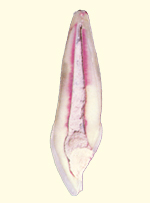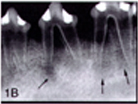Necropulpectomy
The topic use of Calen PMCC as "long last curative" is recommended in the treatment of root canals of pulpless and infected teeth, specially in cases of periapical chronic lesion.

Longitudinal hemisection of an incisive central superior,
evidencing a high infiltration
of the P.M.C.C. Paste.
Necropulpectomy I
It is the didactic designation of the root canal treatment of teeth with necrosed pulp (infected), without pathologic periapical lesion visible in radiography.





